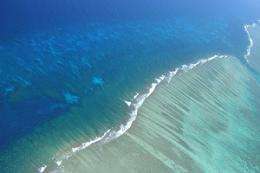Wind 'fights' Leeuwin to provide nutrient rich waters

Researchers investigating the Ningaloo Reef's circulation patterns have discovered that periodic, local wind-driven currents are still strong enough to generate upwelling, providing important nutrients from the seabed to the reef, despite strong suppression from the Leeuwin Current.
The Ningaloo Reef, situated approximately 1200km north of Perth, is Australia's largest fringing coral reef and a UNESCO World Heritage site.
Flowing southward through the Ningaloo Reef down the WA coast, the unique Leeuwin Current system operates much differently to other 'eastern boundary currents' (positioned off the western coast of continents), such as the Humboldt Current off Peru and the California Current off Oregon.
While these systems generate upwelling – where cooler nutrient-rich water from the seabed is driven to the ocean's surface, important for supporting marine ecosystems – the Leeuwin Current subdues upwelling.
However according to PhD student Jiangtao Xu from UWA's School of Environmental Systems Engineering, transient upwelling still occurs in the Ningaloo Reef.
"We wanted to know more about the transient upwelling and circulation patterns along Ningaloo," Mr Xu says.
"It's possible in the future that climate changes will increase the Leeuwin Current's strength and diminish this [transient] upwelling, hence damaging the coral reef."
The researchers conducted field measurements between November 2009 and January 2010 using a Conductivity-Temperature-Depth sampler and an Acoustic Doppler Current Profile to measure current velocities and temperatures at four mooring sites.
Field data was complemented with numerical simulations using broad and fine-scale Regional Ocean Modeling Systems correlated with the global Hybrid Coordinate Ocean Model.
From both data sets researchers confirmed the existence of transient upwelling in the region, and the processes by which it is driven by the wind.
"This process is actually quite interesting … the Leeuwin Current and local wind 'fight' against each other," Mr Xu says.
"The transient upwelling occurs when the wind is more dominant, while the relaxation occurs when the Leeuwin Current is more dominant.
"Our heat budget analysis revealed that without upwelling, the coast water near Ningaloo Reef would be much warmer in summer.
"This transient upwelling to Ningaloo not only advects nutrients to the reef, it also cools down the water temperature, an important factor for preventing reef bleaching in summer."
The upwelling does not appear to be significantly influenced by background flow, indicating that in the foreseeable future it will continue so long as the winds are strong enough.
This paper formed the first part of research that will measure the mechanics and driving forces of the transient upwelling in different seasons.
More information: onlinelibrary.wiley.com/doi/10 … /jgrc.20098/abstract
Provided by Science Network WA


















